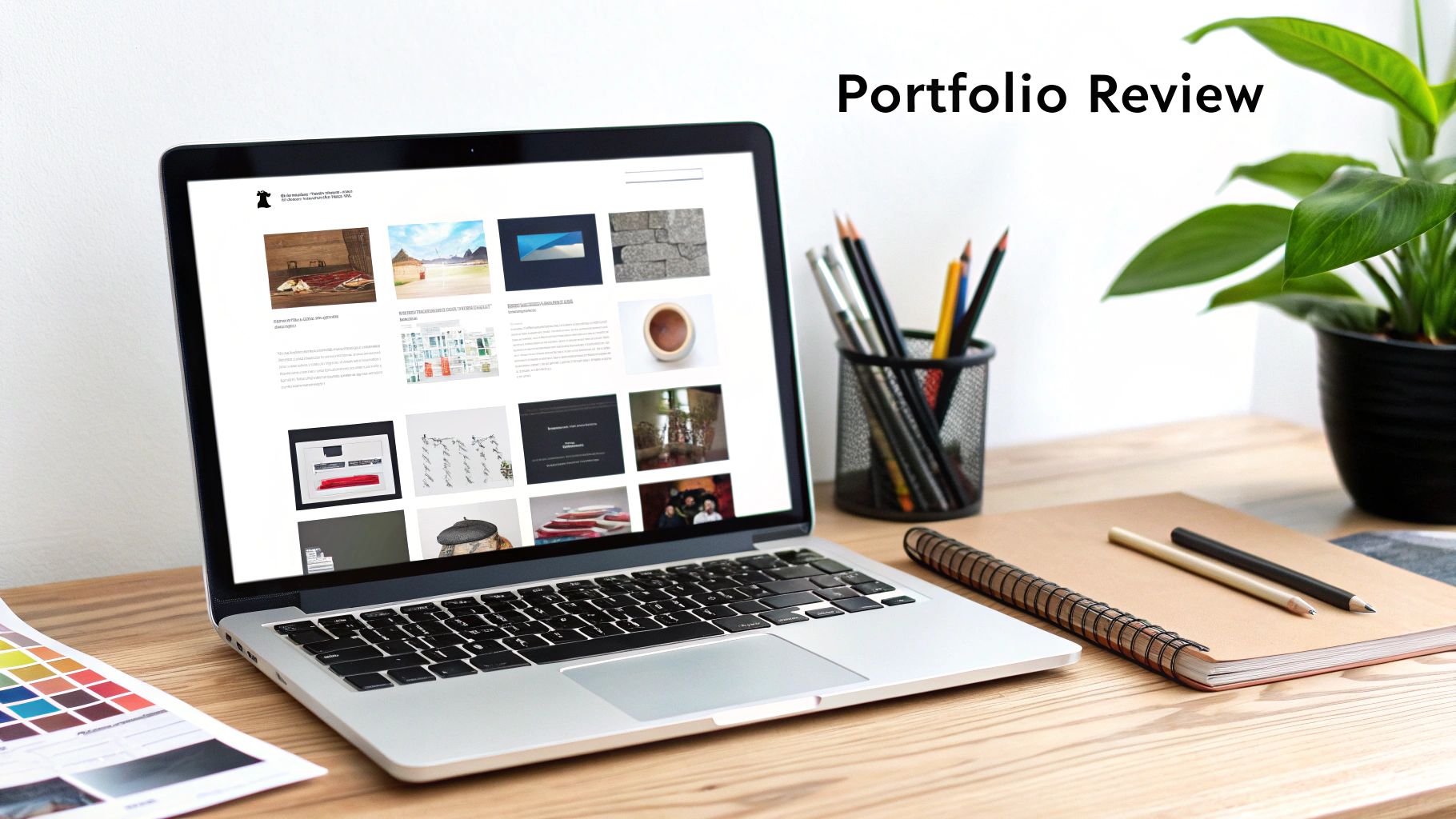Navigating Today's Freelance Design Landscape
The freelance design world is constantly changing, offering businesses a vast pool of talented individuals. Remote work has erased geographical boundaries, allowing collaboration with designers worldwide. This offers businesses an unparalleled number of choices when hiring. However, it also means increased competition for skilled designers. Understanding current trends is crucial for smart hiring decisions.
Specialization and Pricing
One significant trend is specialization. Freelance designers are increasingly focusing on niche areas like UI/UX design, motion graphics, or branding. This allows them to hone their skills and often charge higher rates. For businesses, this means a more focused approach to hiring. Instead of a generalist, finding a designer with skills matching your project often leads to better outcomes. This targeted approach is especially helpful for unique or technically complex projects. For a detailed guide on hiring, check out how to hire a graphic designer.
The Impact of Demographics
Demographic shifts are also impacting the freelance design world. Women now make up a large percentage of graphic designers. This means businesses have a wider and more diverse pool of talent available. Also, the growing number of young professionals entering the field brings fresh ideas and new approaches. These demographic changes show why inclusive hiring practices and diverse experiences are essential. This diversity can lead to innovative solutions for your projects.
To better understand the advantages of hiring freelance designers, let's look at the following comparison:
Freelance Graphic Designer Hourly Rates by Experience Level
A comparison of typical hourly rates charged by freelance graphic designers based on their experience level and specialization
| Experience Level | Logo Design | Web Design | Print Design | UI/UX Design |
|---|---|---|---|---|
| Entry-Level | $20-$40 | $25-$45 | $20-$35 | $30-$50 |
| Mid-Level | $40-$70 | $50-$80 | $35-$60 | $50-$90 |
| Senior-Level | $70-$150 | $80-$150+ | $60-$100 | $90-$200+ |
This table highlights the general range of hourly rates for freelance graphic designers. As you can see, rates increase significantly with experience and vary based on the specific design discipline. For businesses, understanding these rate variations can help in budgeting and selecting the right talent.

The data suggests freelance designers can bring significant benefits. For example, hiring a freelance graphic designer can potentially result in 30% cost savings, cut 5 days off project timelines, and achieve a quality rating of 8 out of 10. These findings demonstrate the potential advantages of using freelance talent. This is especially appealing to businesses looking to maximize their resources and stay competitive. You can also learn more about this in this article: How to master finding and evaluating freelance designers. The freelance market is diverse, with typical earnings ranging from $20 to $150 per hour, depending on experience, location, and the project type.
Where the Best Designers Are Actually Hiding
While platforms like Upwork and Fiverr are often the first stops for businesses seeking freelance graphic designers, truly exceptional talent can be harder to find. These popular sites can be overwhelming, making it a challenge to identify the real standouts among numerous profiles. So where do you find these design experts?
Beyond the Mainstream Job Boards
Many highly skilled designers prefer alternative platforms. They gravitate towards niche communities and rely on direct referrals. For instance, design communities on platforms like Dribbble and Behance offer a more focused selection of talent. These platforms prioritize portfolio quality and creative excellence, allowing designers to showcase their work and connect with clients based on shared aesthetics and project goals.
Tapping Into Hidden Talent Networks
Many top designers rely on word-of-mouth referrals and private networks. Networking within the design community and attending industry events can be invaluable for discovering hidden talent. Reaching out to design agencies or creative directors for recommendations can also connect you with designers who may not be actively seeking work but are open to new opportunities. When exploring options for finding freelance graphic designers, consider related services like hiring someone to build a Shopify store if you're also developing an online store.
The Rise of the Freelance Revolution
The freelance landscape is constantly evolving, and the global freelance workforce is booming. More and more individuals are embracing freelance careers, including in graphic design. As of 2025, the number of freelancers worldwide has reportedly reached 1.57 billion, representing almost 47% of the global workforce. This growth indicates a shift towards flexible work arrangements and the gig economy.
Freelancers in the graphic design niche are a significant part of this expansion. Platforms like Fiverr anticipate 10-12% annual growth in their freelance user base, projecting to facilitate around 25 million freelance jobs in 2025 alone. Graphic design ranks among the most in-demand services. More detailed statistics on graphic design growth can be found here. This expanding talent pool presents both more options and greater competition.
Finding Your Perfect Design Partner
Finding the ideal designer requires a strategic approach. It's essential to identify platforms that align with your project requirements and budget.
To help you navigate your options, the following table compares several leading platforms for hiring freelance graphic designers:
Top Platforms for Hiring Freelance Graphic Designers
This table compares major freelance platforms and specialized design marketplaces, highlighting their key features, typical designer quality, and pricing models.
| Platform | Designer Quality | Price Range | Project Types | Vetting Process |
|---|---|---|---|---|
| Upwork | Varied | Wide range | Diverse, from logo design to web design | Client reviews, skill tests, portfolio reviews |
| Fiverr | Varied | Wide range | Diverse, often packaged services | Seller levels, client reviews, portfolio reviews |
| Dribbble | High | Mid-range to High | Primarily visual design, branding | Portfolio based, community recognition |
| Behance | High | Mid-range to High | Portfolio showcase, client connections | Portfolio based |
| 99designs | Varied | Mid-range | Logo design, web design, contests | Designer contests, client feedback |
This overview provides a starting point for exploring the strengths and weaknesses of each platform. Remember, the best platform for you depends on your specific needs and priorities.
Finding the right designer may require some effort, but the payoff is significant. A little research can uncover exceptional talent and elevate your project to the next level.
Crafting Project Briefs That Attract Top Talent

The success of any design project depends heavily on clear communication between the client and the freelance graphic designer. A well-written project brief is the foundation of this communication, acting as a roadmap for the designer and ensuring the final product matches your vision. This section will show you how to create a compelling brief that attracts the best freelance graphic design talent.
Essential Elements of a Winning Brief
A good project brief attracts skilled designers. It provides clarity, sparks creativity, and ultimately leads to a successful partnership. Keep these essential elements in mind:
-
Project Overview: Start with a concise summary of your project, including its goals and objectives. This gives context to the designer and helps them understand the design's purpose. Are you refreshing your brand identity, designing marketing materials, or creating a new website?
-
Target Audience: Define your target audience. Who are you trying to reach with this design? Understanding the audience's demographics, preferences, and needs helps the designer tailor their work. This allows for informed decisions about style, tone, and visuals.
-
Scope of Work: Clearly state the deliverables you expect, such as logo design, website mockups, social media graphics, or other design assets. Define the number of revisions included upfront to manage expectations and prevent scope creep, keeping the project on track.
-
Brand Guidelines: If you have established brand guidelines, share them with the designer. This maintains consistency with your brand identity and offers a framework for the design process. Giving details on your brand’s personality, values, and visual style helps the designer maintain a cohesive look.
-
Budget and Timeline: Be transparent about your budget and timeline. This allows designers to decide if the project aligns with their availability and pricing. A realistic timeline prevents rushed work and ensures time for revisions and feedback.
Communicating Your Vision Effectively
While a structured brief is essential, effective communication goes beyond listing requirements. Here are some tips:
-
Use Visual Inspiration: Share examples of designs you admire. This gives the designer a visual understanding of your preferences, helping them align their work with your aesthetic vision. It's like showing a chef examples of dishes you like instead of just describing flavors.
-
Articulate Your Vision, Not the Solution: Explain the message you want to convey and the feeling you want to evoke. This gives the designer creative freedom while staying true to your overall vision. You’re hiring a freelance graphic designer for their expertise—trust them to interpret and bring your vision to life.
-
Ask Clarifying Questions: Talk with potential designers to make sure they understand your brief and have the right skills for the project. Ask about their experience with similar projects and their design approach. Learn more in our article about How to master the creative brief.
Examples and Templates
Using templates and real-world examples can improve the clarity and effectiveness of your brief. Many online resources offer free templates and examples to get you started. These resources often provide a structure that ensures you cover all the essentials, making your brief easier for designers to understand.
By following these guidelines, you can create a project brief that attracts top freelance graphic designers and sets the stage for a successful collaboration. A strong brief not only attracts talent but also ensures everyone is on the same page from the start, minimizing revisions and maximizing the chances of a fantastic final product.
Evaluating Designers Beyond Just Pretty Portfolios

A captivating portfolio is often the first thing that grabs your attention when searching for a freelance graphic designer. But relying only on visual appeal can be deceptive. This section explores how to strategically evaluate freelance designers to find truly exceptional talent. It's about understanding their thinking process, not just admiring the final product.
Uncovering Strategic Thinking
Exceptional designers don't simply create visually appealing work; they solve problems. Their portfolio should showcase this strategic thinking. Look for projects where the designer clearly outlines the client's objectives and explains how their design solutions met those goals.
Did the designer increase brand visibility? Improve user experience? Drive conversions? These are the questions you should be asking. A portfolio demonstrating a clear understanding of design's business impact is far more valuable than one filled with only beautiful images.
Deciphering Client Testimonials
Client testimonials provide insights into a designer's work ethic and communication skills. Don't just scan for positive words; look for concrete examples. How did the designer handle challenges? Did they meet deadlines? How did they incorporate client feedback?
If possible, try contacting past clients directly. A direct conversation can reveal far more than a written testimonial, offering a more complete understanding of the designer's capabilities.
The Power of Targeted Questions
Asking the right questions during the interview process is crucial. Inquire about their design process, how they overcome creative blocks, and their experience with various project types. You might be interested in: How to master interview questions for your graphic design needs.
Present a hypothetical design challenge to assess their analytical and critical thinking skills. The answers will reveal more about their practical experience than their portfolio alone.
Red Flags and Assessment Frameworks
Experienced hiring managers know the red flags to watch out for. Inconsistent communication, missed deadlines, and a lack of understanding of project briefs are all warning signs.
Develop an assessment framework to avoid these pitfalls. This framework could include a test project, a portfolio review, and client interviews. A structured approach ensures consistent and fair evaluation of candidates and streamlines the hiring process, minimizing the risk of a bad hire.
Test-Driving the Relationship
Before committing to a long-term project, consider a smaller trial project. This lets you evaluate the designer's work style, communication, and ability to meet your specific needs.
Think of it as a test drive. It provides a real-world glimpse into how the designer operates. This practical approach can significantly reduce the risks associated with hiring a freelance graphic designer. By thoroughly evaluating designers beyond their portfolios, you can find a skilled professional who creates beautiful designs and strategically contributes to your business goals. This ultimately leads to more successful collaborations.
Setting Fair Rates That Attract Exceptional Talent

Finding the right rates for freelance graphic designers is key to attracting top talent. It requires understanding how designers determine their pricing and what motivates them to take on projects. It's about more than just competitive hourly rates; it's about recognizing their value.
Understanding Designer Pricing Strategies
Top freelance graphic designers weigh several factors when setting their rates. Experience is a major one, with seasoned designers often commanding higher fees. Specialization also matters. A designer focused on a niche like UI/UX design or motion graphics will usually charge more than a generalist. Project complexity also plays a crucial role. A complex project with extensive research and revisions will naturally cost more than a straightforward design.
Factors Beyond the Hourly Rate
The hourly rate is important, but other factors influence a designer's decision. These can include the project's creative potential, the client's communication style, and how well the project aligns with the designer's portfolio and interests. A designer passionate about sustainability, for instance, might accept a lower rate for a project that reflects those values. A designer building their portfolio might tackle a challenging project even with a tighter budget. For more information, check out this helpful resource: How to master setting your freelance rates.
Frameworks for Fair Compensation
Determining fair compensation requires a strategic approach. Consider the project's strategic value to your business. A project vital to your brand's success warrants a higher investment in design talent. The competitive advantage the design offers is also important. Unique and impactful design sets you apart, making a premium for exceptional work worthwhile. Don't just rely on market averages; consider the specific value the designer brings.
Innovative Compensation Models
Beyond hourly or project-based rates, some companies explore alternative compensation. Some offer performance-based bonuses tied to outcomes like increased website traffic or sales. Others use value-based pricing, linking the fee to the perceived value of the work. This might combine a base fee plus a percentage of revenue generated by the design. These approaches align incentives, creating a mutually beneficial situation.
Respecting Creative Expertise
When negotiating rates, respect the designer's expertise and value. Recognize that quality design is an investment with significant potential returns. By understanding designer pricing and exploring different compensation models, you can attract exceptional talent and build strong creative partnerships. A well-compensated designer is more invested in the project, leading to better results for everyone.
Building Bulletproof Agreements That Protect Everyone
The foundation of a successful collaboration with a freelance graphic designer hinges on a well-structured agreement. This ensures a smooth working relationship, protects both you and the designer, and clarifies expectations from the outset. Going beyond basic templates, this section guides you through crafting comprehensive contracts that build trust and prevent common disputes.
Essential Elements of a Design Contract
A robust contract should cover several key aspects:
-
Project Scope: Clearly define the project’s goals, deliverables (logo design, website mockups, etc.), and timelines. This prevents misunderstandings and scope creep, where the project expands beyond the initial agreement.
-
Payment Terms: Specify the payment amount, schedule (milestones, upfront payment, etc.), and methods. Be explicit about kill fees, which compensate the designer for completed work if the project is terminated early.
-
Revision Cycles: Outline the number of revisions included in the initial agreement. This manages expectations and provides a framework for handling revisions beyond the agreed-upon limit.
-
Intellectual Property (IP) Rights: Clearly define who owns the copyright and usage rights for the final designs. Determine if the designer retains any rights for portfolio use or future adaptations. Understanding IP ownership is crucial for both parties.
-
Confidentiality: Include clauses protecting confidential information shared during the project. This ensures sensitive business details remain private.
Addressing Sensitive Issues With Clarity
Addressing potentially sensitive issues upfront can strengthen the working relationship. This includes:
-
Kill Fees and Project Termination: While no one anticipates project termination, having a clear process in place, including kill fees, protects both the client and the designer if the project ends prematurely.
-
Disputes and Mediation: Outline a process for resolving disputes. This may involve mediation or arbitration, providing a structured approach to address issues without resorting to legal action.
International Collaboration and Legal Jurisdictions
When working with international freelance graphic designers, consider these points:
-
Legal Jurisdiction: Specify which country’s laws govern the contract in case of disputes.
-
Payment Methods and Currencies: Outline acceptable payment methods and agree on the currency to avoid confusion and exchange rate fluctuations.
-
Communication and Time Zones: Establish clear communication channels and account for time zone differences to ensure smooth project flow.
Beyond Legal Templates: Building Trust
A good contract is not just about legal protection; it's about fostering trust. Experienced designers appreciate:
-
Clear Communication: A contract reflecting clear, concise language shows professionalism and builds confidence.
-
Respect for Creative Work: Recognizing the value of the designer’s creative input and expertise creates a positive working environment.
-
Fair Compensation: Offering fair rates and payment terms demonstrates respect and motivates designers to deliver their best work.
Structuring Revision Cycles to Prevent Scope Creep
Managing revisions effectively is essential. A defined revision process prevents endless back-and-forth and keeps the project within scope. Consider these strategies:
-
Fixed Number of Revisions: Specifying a set number of revisions within the agreed-upon fee encourages focused feedback and streamlines the design process.
-
Revision Requests in Writing: Requesting revisions in writing ensures clarity and creates a record of changes.
-
Charging for Additional Revisions: Establish a clear process for handling and charging for revisions beyond the agreed-upon limit.
By carefully addressing these aspects in your agreements, you can create robust contracts that not only protect everyone involved but also set the foundation for a productive, long-term collaboration with your freelance graphic designer. Remember, a strong agreement is an investment in a successful project.
Fostering Partnerships That Deliver Breakthrough Results
Hiring a freelance graphic designer can sometimes feel like a simple transaction, a one-and-done project. But smart businesses know the real magic happens when you build lasting partnerships. These long-term relationships can completely change your approach to creative projects and consistently deliver outstanding work.
Transforming Transactions into Collaborative Alliances
Building a strong partnership with a freelance graphic designer means moving beyond simply assigning tasks and receiving the finished product. It requires open communication, mutual respect, and a shared understanding of your goals. Think about needing a logo refresh, for example. A transactional approach involves sending a brief and waiting for the final design. A collaborative approach, on the other hand, involves ongoing discussions, sharing inspiration, and providing feedback throughout the design process. This builds a sense of shared ownership and ultimately leads to better results.
Communication Practices That Inspire
The best creative directors know that clear and inspiring communication is key to getting great work from designers. This starts with a detailed project brief that outlines the project's goals, target audience, and desired aesthetic. But effective communication goes beyond the initial brief. It involves regular check-ins, open conversations about creative challenges, and a willingness to listen to the designer's perspective. This open dialogue creates a collaborative environment where designers feel valued and empowered.
Providing Feedback That Elevates
Feedback is essential for any creative project. But giving feedback that's both helpful and encouraging can be tricky. Instead of focusing on what's wrong with a design, try framing your feedback around how the design can better achieve the project goals. For instance, instead of saying, "I don't like this color," you could say, "I think a warmer color palette would better resonate with our target audience." This approach helps designers understand your reasoning and encourages them to explore different solutions.
Structuring Ongoing Relationships
Many successful businesses structure ongoing relationships with freelance designers through retainer agreements. These agreements guarantee a set number of hours or projects each month, giving the designer consistent work and the business reliable access to design expertise. You might be interested in: Learn more about creative staffing solutions. This predictable workflow helps both parties plan effectively and develop a deeper understanding of each other's working styles.
Becoming the Client of Choice
Building a strong reputation as a client is crucial for attracting and keeping top design talent. The best designers often choose clients who provide clear briefs, offer fair compensation, and create a collaborative work environment. They're also more likely to recommend these clients to others, creating a network of positive referrals. By treating freelance designers as valued partners, you can build a reputation that attracts the best talent and achieves exceptional results. Ready to elevate your creative projects? Explore the power of collaborative partnerships and see how Creativize can connect you with exceptional freelance graphic designers.

